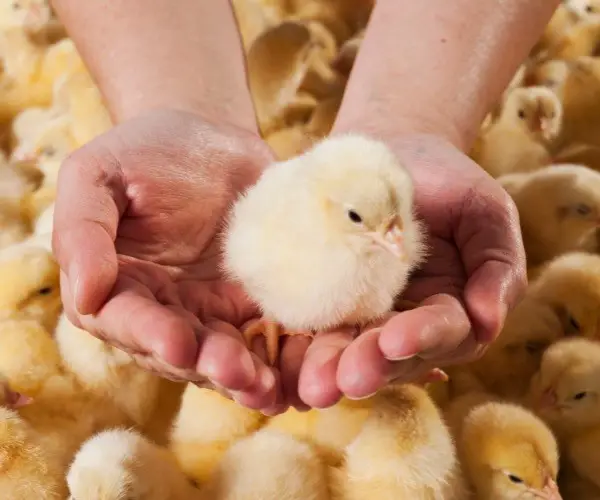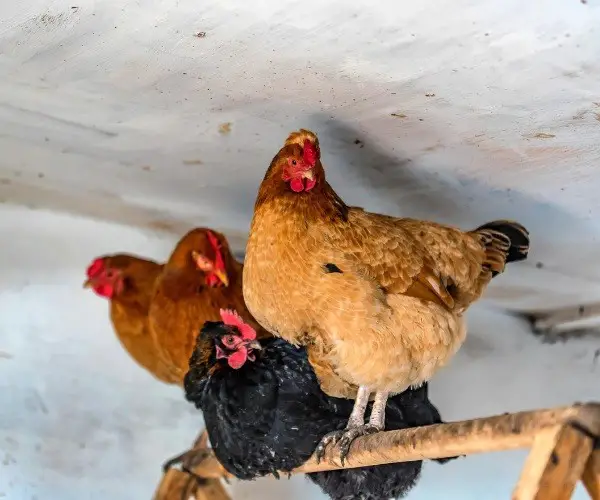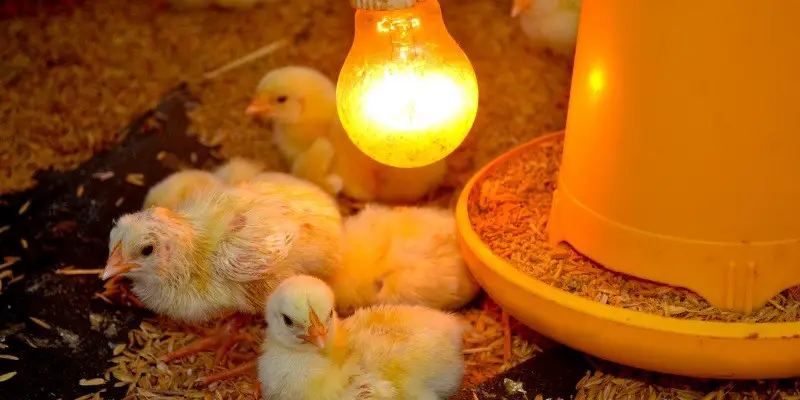Last Updated on January 14, 2025 by Pauline G. Carter
Chickens are hearty birds and can withstand cold weather much better than extreme heat. However, newborn chicks cannot regulate their body temperature and must have a heat source to survive. A heat lamp is the most common way to provide warmth for chicks, but what happens if the power goes out and the heat lamp goes out with it?
Will the chicks die? The simple answer is, yes, chicks will die without a heat lamp. However, there are some things you can do to minimize the risk.
First, if you live in an area that is prone to power outages, have a backup heat source ready to go. A small propane heater or even a hair dryer can work in a pinch. Second, if the power does go out, act quickly.
Get the chicks into a warm, sheltered area as soon as possible. A garage or shed with no drafts is ideal. If you have a brooder set up, move the chicks into it.
Finally, keep a close eye on the chicks and their body temperature. If they start to get cold, give them a little extra warmth.
If you live in a cold climate, you’ve probably wondered if you need a heat lamp for your chickens. After all, chickens are warm-blooded animals and need to maintain their body temperature. The truth is, chickens can withstand cold temperatures better than you might think.
They have natural downy feathers that insulate them against the cold. As long as they have access to shelter and a dry, draft-free place to roost, they will be fine. That said, there are certain situations where a heat lamp may be necessary.
If your chickens are very young or old, or if they are sick, a heat lamp can help them stay warm. It’s also a good idea to use a heat lamp if your chickens are molting, as they will need all the help they can get to grow new feathers. So, in conclusion, chickens can die without a heat lamp but it’s not likely.
If you’re worried about your chickens being cold, just make sure they have a warm, dry place to roost and they’ll be fine.
How long do chickens need to be under a heat lamp?
When chicks are first born, they are unable to regulate their own body temperature and must be kept warm under a heat lamp. The ideal temperature for chicks is between 95-100 degrees Fahrenheit. Chicks can be kept under a heat lamp for the first 3-4 weeks of their life.
After that, they should be slowly transitioned to cooler temperatures until they are fully feathered and can regulate their own body temperature.
Baby chick temperature chart
When it comes to keeping your baby chicks warm, there is a Goldilocks situation – not too hot and not too cold. The temperature needs to be just right. A good rule of thumb is to keep the temperature at 95-100 degrees Fahrenheit for the first week, then lower it by 5 degrees each week until it reaches 70 degrees.
You can use a simple desktop lamp with a 60-watt light bulb to provide warmth, or you can purchase a special brooder lamp designed for baby chicks. Either way, make sure the lamp is placed out of reach of the chicks so they can’t knock it over and hurt themselves. You’ll also need to keep an eye on the temperature inside the brooder.
A good way to do this is to use a thermometer placed at chick level. Check the temperature several times a day to make sure it’s staying consistent. If you find that the temperature is too low, you can raise it by adding another lamp or moving the brooder closer to a heat source.
If the temperature is too high, you can lower it by moving the brooder away from the heat source or by removing a lamp. By following these simple guidelines, you can make sure your baby chicks stay warm and comfortable – and ready to take on the world!
How to warm up a baby chick?

When it comes to warming up a baby chick, there are a few things you need to take into account. The first is the temperature of the chick itself. If the chick is too cold, it will be unable to generate enough body heat to warm itself up.
The second is the temperature of the environment the chick is in. If the environment is too cold, the chick will not be able to warm itself up. The third and final factor is the amount of time the chick has been cold.
If the chick has only been cold for a short period of time, it will be able to warm itself up more quickly than if it has been cold for a longer period of time. Now that you know the three factors to take into account when warming up a baby chick, let’s go over the best way to do it. The first thing you need to do is take the chick out of the cold environment and place it in a warm one.
The best way to do this is to put the chick in a covered container with a heating pad set on low. Once the chick is in a warm environment, you need to slowly increase the temperature of the heating pad. You should do this over the course of an hour or so until the chick is warm to the touch.
Once the chick is warm, you can remove it from the container and place it in a brooder.
When do chickens need heat in coop?

Chickens are cold-blooded animals, meaning that they cannot generate their own body heat. This means that they are especially susceptible to cold weather and need a warm place to stay warm. The amount of heat that chickens need depends on the outside temperature and the age and breed of the chicken.
In general, chickens need a minimum of 18-20 degrees Celsius to stay warm. However, younger chickens and certain breeds (such as bantams) may need a bit more heat. If the temperature outside is below 18 degrees, you may need to provide a heat source for your chickens.
This can be done with a heat lamp, a ceramic heat emitter, or a brooder.
Diy heat lamp
If you’re looking for a cost-effective way to keep your plants warm during the winter months, a DIY heat lamp may be the answer. Heat lamps are available for purchase online or at your local home improvement store, and with a few simple supplies, you can easily create your own. Here’s what you’ll need to get started:
- A heat lamp with a stand
- A light bulb (either incandescent or LED)
- A power strip
- A timer (optional)
To assemble your heat lamp, simply screw the light bulb into the socket on the heat lamp. Then, plug the power strip into an outlet and plug the heat lamp into the power strip.
If you’re using a timer, set it for the desired length of time and turn it on. That’s it! Your DIY heat lamp is now ready to use.
Position it so that the light bulb is close to, but not touching, the plants you wish to keep warm. The heat from the bulb will radiate outward, providing warmth for your plants. Keep in mind that heat lamps should only be used for a few hours at a time, as too much heat can be damaging to plants.
When not in use, be sure to unplug the heat lamp and power strip to avoid any accidents.
Can chickens survive without a heat lamp?
Chickens are able to survive without a heat lamp, although they will not thrive. Chickens are cold-blooded animals and their body temperature is dependent on the temperature of their surroundings. In warm weather, they are able to regulate their body temperature by panting and in cold weather, they will fluff up their feathers to create insulation.
When the temperature drops below freezing, they will stop laying eggs. Chickens are also susceptible to frostbite, so it is important to provide them with a warm, dry place to sleep if the temperature outside is very cold.
What happens if chickens don’t have a heat lamp?
Chickens are able to regulate their own body temperature for the most part, but in cooler weather, a heat lamp can help them stay warm. If they don’t have a heat lamp, they may huddle together to keep warm or may roost in a warm spot. Chickens can also suffer from frostbite if they are exposed to too cold of temperatures, so it’s important to make sure they have some form of heat source if the weather is chilly.
How cold is too cold for chickens?
Chickens are fairly tolerant of cold weather, but there is such a thing as too cold for them. If the temperature drops below freezing, they can start to experience frostbite on their combs and wattles (the fleshy protrusions on their heads). In extreme cold, they may even stop laying eggs.
To keep your chickens comfortable in winter, make sure they have a warm, dry place to sleep at night. A good rule of thumb is to provide them with one square foot of space per chicken. You can also give them a heat lamp to keep them warm, but be sure to keep it out of reach so they can’t accidentally knock it over and start a fire.
If you live in an area that gets very cold in winter, you may need to take extra steps to keep your chickens warm. One option is to build a chicken coop that is insulated and has a south-facing window to let in the sun’s warmth during the day. You can also consider getting a breed of chicken that is known for being particularly hardy in cold weather, such as the Rhode Island Red.
In general, as long as you take steps to keep them warm and dry, your chickens should be able to handle most winter weather. But if the temperature drops below freezing and stays there for extended periods of time, it’s best to bring them inside to make sure they stay safe and comfortable.
How do I keep my chickens warm without a light?
There are a few things you can do to keep your chickens warm without using a light. First, make sure their coop is well-insulated. You can do this by adding extra insulation to the walls and ceiling, or by using a tarp to cover the outside of the coop.
Second, provide your chickens with a heated water source, such as a heated water bowl or a chicken waterer. This will help them stay hydrated and warm. Finally, give your chickens access to a dust bath.
This will help them keep their feathers clean and dry, which will insulate them against the cold.
Raising chicks without a heat lamp (Video)
Conclusion
Chickens are able to withstand cold weather but they will die if exposed to extreme cold or without a heat source. A heat lamp is not required but it will help keep them warm and comfortable. Chickens should have access to a coop or shelter to protect them from the elements.

